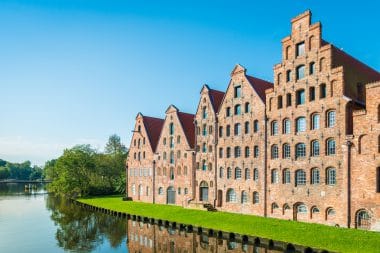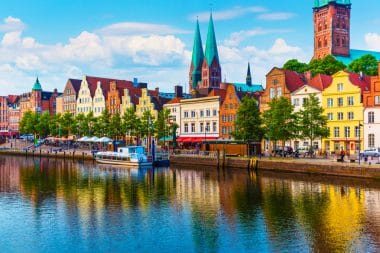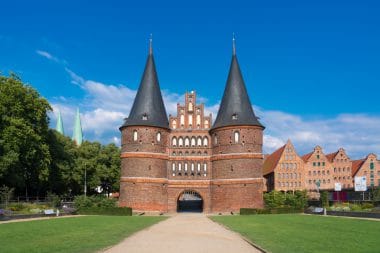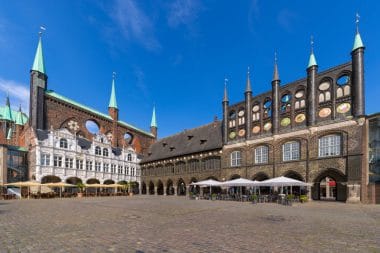Lübeck is a Hanseatic city worth seeing and, with about 217,000 inhabitants, the second largest city in the state of Schleswig-Holstein. Lübeck’s medieval old town with its many cultural monuments has been part of the UNESCO World Heritage Site since 1987. Old merchants’ houses, winding alleys and sacred buildings worth seeing attract visitors to the historic old town again and again. Lübeck also has one of the largest ferry ports in Europe.
Lübeck – the city of Nobel Prize winners

Bonn can boast of being the birthplace of Ludwig van Beethoven, Hamburg is the birthplace of Chancellor Helmut Schmidt, but Lübeck can be proud of three Nobel Prize winners. Thomas Mann (Nobel Prize for Literature 1929), Willy Brandt (Nobel Peace Prize 1971) and Günter Grass (Nobel Prize for Literature 1999) considered Lübeck their home. Worth seeing are the literature museum “Buddenbrookhaus” in the old town, the Günter Grass House, a forum for literature and fine arts and the Willy Brandt House with exhibitions on contemporary history.
Marzipan as a remedy?

Who thinks of a remedy when eating delicious marzipan products? Originally, marzipan was produced by pharmacists at the beginning of the 18th century as a remedy. If you want to know more about the interesting history of marzipan, you should visit the Niederegger Marzipan Salon. On the 2nd floor of Café Niederegger, the story of the creation of marzipan is vividly explained. If you want, you can also learn something about the history of the Niederegger company and take part in a modelling demonstration and experience first-hand how marzipan figures are made.
Harbour flair
More than 20 historic sailing ships and historic watercraft have their berths in the museum harbour. Some of them are up to 150 years old. The Museum Harbour Association was founded in 1981. He is committed to keeping the past times alive.
View Lübeck from a different perspective
On harbour and canal cruises, you can sit comfortably on or below deck and learn something about the seafarers and merchants who sailed around the city 800 years ago. There are also funny anecdotes and interesting explanations from the captain. A lock trip on the over 100-year-old and natural Elbe-Lübeck Canal is also a special and certainly “uplifting” experience.
Fishing port Travemünde
Attention – you should hold the fish sandwich tightly, otherwise the seagulls will like to grab it in low flight. In the fishing port of Travemünde, you can sit in the sun, enjoy the view of the Trave and watch how the fishermen sell their goods directly from the cutter.
Lübeck for Art Lovers – Historical Buildings and Modern Art

Lovers of culture, history and maritime lifestyle will get their money’s worth. Lübeck offers its visitors a wealth of important buildings and imposing churches, as several art epochs have left their mark on the city.
St. Mary’s Church
Built between 1250 and 1350, St. Mary’s Church is an important place of worship. It was built by merchants and was intended to tower over the previous churches. With a height of 38.5 meters, St. Mary’s Church is actually the highest brick vault in the world, the two towers are each over 120 meters high.
The famous Holsten Gate
The Holsten Gate is the landmark of the city of Lübeck and probably the most famous gate in Germany. It was built between 1464 and 1478 by Hinrich Helmstede as part of a modernisation of the fortifications. Besides the Burgtor, the Holsten Gate is the only surviving city gate in Lübeck.
Worth seeing – the TheaterFigurenMuseum

A special kind of attraction is the TheaterFigurenMuseum, which was founded by Fritz Fey and is now known far beyond the borders of Lübeck. On his travels, which he undertook as a cameraman, Fritz Fey, born in 1940, collected figures wherever he could get them. These included marionettes, ventriloquist figures, transformation dolls and, of course, the popular Punch and Judy figures. In the theatre there are hundreds of figures from three centuries and several continents to marvel at. In addition, many utensils are shown that belong to a real theater. Props, backdrops, posters and musical instruments. A truly fascinating exhibition that has already inspired many thousands of visitors.
The unique Lübeck Water Marionette Theatre
Young and old are captivated in the Water Marionette Theatre. Language plays a rather subordinate role here, because the content should be conveyed through colours, music, light and spatial experiences. Visitors to the underwater puppet theatre are visually and sonically transported to another world. The game with underwater figures takes place in a specially developed theater aquarium with 800 to 3000 liters of water.
The Nordic Film Days in Lübeck

In 1956, the Lübeck Film Club organized the “Nordic Film Days Lübeck” for the first time, which is now one of the most traditional film festivals in the world. It is the only festival in Germany and on the European mainland that specialises entirely in the presentation of films from the north and northeast of the continent. Every year, the latest short films, feature films and documentaries from Sweden, Iceland, Norway, Finland, Denmark, Lithuania, Latvia and Estonia are presented here for 5 days.
Lübeck from above
Past the bell room, carillon and wall crown, the path leads on a tour of the tower and vault of St. Mary’s Church. Under a huge roof, you can look through window hatches or into open work gates. If you have made it to the roof turret, you can even see as far as Mecklenburg and Travemünde on a clear day.
The Petri Church is also famous for its 50 mtr. high viewing platform is a popular destination. From the top you have a great view over the whole city.


